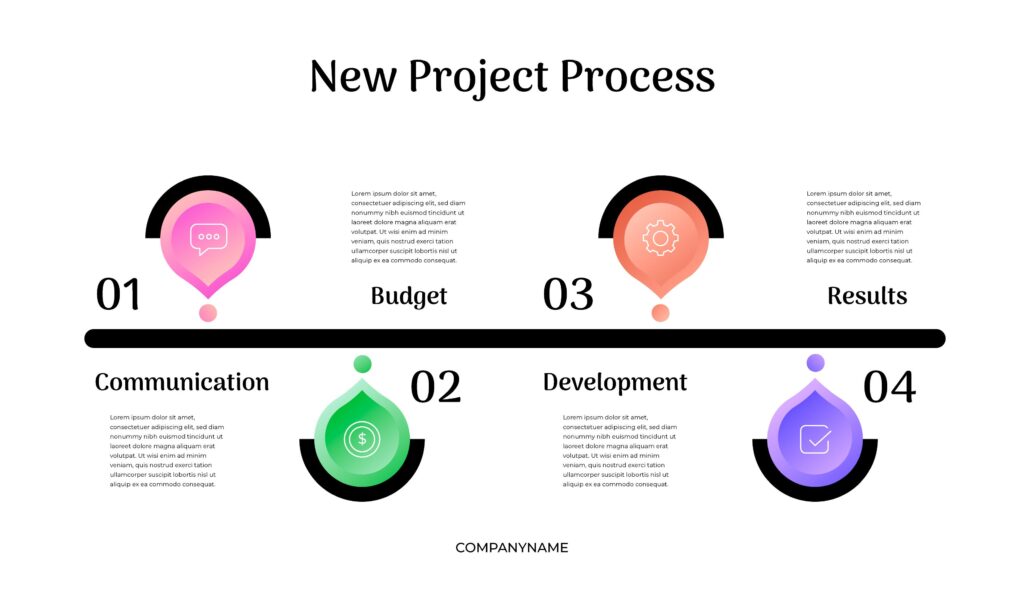
Successful projects rely on a strong foundation of mutual understanding. When expectations are clearly set and managed effectively throughout the project lifecycle, both clients and service providers experience a smoother, more rewarding collaboration.
This article equips you with practical strategies to cultivate clear communication, navigate project scope, and ultimately, deliver exceptional results that exceed client expectations.
Table of Contents
Key Takeaways
- Clear & Consistent Communication: From initial planning to project completion, prioritize open communication with clients. This builds trust and helps manage expectations effectively.
- Align Expectations with Reality: Understand client goals and set achievable timelines and budgets. Proactively address challenges to prevent surprises.
- Deliver Quality & Value: Exceed client expectations by delivering exceptional work on time. Regularly seek feedback to continuously improve your services.1. Essentials of Clear Communication.
Essentials of Clear Communication

Establish Communication Plan
Establishing a communication plan with clients from the start is crucial. Clearly outline how often you will have phone calls or meetings to discuss project progress. Setting expectations early helps prevent misunderstandings later on.
Regularly updating clients on project progress is essential to maintain transparency and trust. By keeping them informed, you can address any concerns promptly and avoid potential issues. This proactive approach shows clients that you value their input and are committed to delivering results that meet their expectations.
Develop a communication plan template that outlines preferred communication methods (email, calls, project management software), frequency of updates (weekly, bi-weekly), and who will be the primary point of contact on each side.
Use Simple Language
Using simple language when communicating with clients is key to avoiding misunderstandings. Avoid technical jargon or complex terms that may confuse them. Instead, explain concepts in a clear and concise manner that they can easily understand.
By simplifying your language, you ensure that clients are fully informed about the project’s status and any challenges that may arise. This approach fosters open communication and encourages clients to share their feedback without feeling overwhelmed by industry-specific terminology.
Update Clients Regularly
Regular updates are essential for effective client expectation management. Whether through emails, phone calls, or in-person meetings, providing regular updates reassures clients that their project is progressing as planned. These updates also allow you to address any red flags early on before they escalate into larger issues.
Instead of saying ‘we’ll keep you updated,‘ specify the update frequency. For example, ‘you’ll receive a progress report with next steps every other Monday.‘
Defining Project Scope and Milestones

Documenting Deliverables
Project scope outlines the boundaries of a project, defining what will be included and excluded. Milestones are significant points within the project timeline that signify progress. By documenting all agreed-upon terms and deliverables, both parties have a clear reference point.
Utilize project management tools that allow for visual representation of scope and milestones. Gantt charts or Kanban boards can provide a clear roadmap for both you and the client.
Setting Clear Milestones
Establishing milestones helps track progress, ensuring the project stays on schedule. These checkpoints allow for adjustments if needed to meet deadlines effectively. Clear communication about milestones is crucial for client satisfaction.
For instance, when negotiating additional work terms, clearly define the new deliverables and their impact on the timeline and budget. Put it in writing and get client sign-off before proceeding.
Negotiating Additional Work Terms
Negotiating additional work terms upfront is essential to manage scope effectively. Clearly outlining what falls within the initial agreement and what constitutes extra work prevents misunderstandings later on. This proactive approach fosters trust between clients and service providers.
Realistic Expectations and Strategies

Pricing and Market Considerations
When setting project pricing, it’s vital to consider market trends and competitors’ rates. Conducting a thorough market analysis can help determine competitive yet profitable pricing strategies.
Understanding the market dynamics allows you to anticipate changes and adjust pricing accordingly. This proactive approach helps in meeting customer expectations while staying competitive in the market.
Timeline Management
Establishing a realistic project timeline is crucial for managing customer expectations. It’s important to factor in potential delays or unforeseen challenges when creating the project timeline.
By incorporating buffer time into the schedule, you can handle unexpected setbacks without compromising project quality. Effective timeline management ensures timely delivery and meets customer expectations.
Addressing Key Questions
Encourage open communication by addressing customer questions promptly and transparently. Clearing any doubts or concerns early on helps in aligning customer expectations with project outcomes.
Creating a FAQ document or hosting Q&A sessions can streamline the process of addressing common customer questions. This proactive approach fosters trust and enhances overall customer satisfaction.
Handling New Challenges
Be prepared to adapt to new challenges that may arise during the project lifecycle. Flexibility is key to managing unexpected hurdles while maintaining customer expectations.
Developing contingency plans for various scenarios enables quick responses to unforeseen events. By proactively addressing new challenges, you can uphold project integrity and exceed customer expectations.
The Power of Listening and Empathy

Active Engagement
Listening attentively to clients is crucial in managing expectations effectively. By showing genuine empathy, you can understand their needs better and provide tailored solutions.
Clients appreciate when they feel heard and understood, leading to stronger relationships and trust. This approach fosters a positive atmosphere for open communication.
Therefore, try to actively listen by summarizing key points and asking clarifying questions. This demonstrates understanding and encourages further client input.
Responsive Communication
Maintaining honesty in all interactions conveys respect and builds credibility. Respond promptly to client feedback, addressing concerns with transparency and care.
By actively engaging with their input, you demonstrate a commitment to their satisfaction. This proactive stance can prevent misunderstandings and enhance the overall experience.
Personalized Support
Offering personalized attention demonstrates your dedication to each client’s unique situation. Tailor your responses based on their specific requirements, ensuring they feel valued and prioritized.
Creating a detailed list of preferences or concerns helps you address their needs more effectively. This personalized approach can lead to increased satisfaction and loyalty.
Timely Access
Providing timely access to information or resources is essential for managing client expectations efficiently. Ensure they have the necessary permissions or tools required for a smooth process.
Promptly addressing any hurdles or delays shows your commitment to their success. By offering quick solutions, you instill confidence in your ability to meet their needs effectively.
You can start by developing a system for tracking and addressing client concerns. Assign an owner to each issue and communicate a resolution timeline to the client.
Navigating Scope Management Effectively
Over-Communicate
Maintain open communication channels throughout the project to ensure everyone is on the same page regarding project scope. Discuss any potential scope changes promptly and update clients on progress and deviations from the initial plan.
Capture Changes
Document all scope changes in writing to avoid misunderstandings down the line. Keep a detailed record of alterations made, including reasons for the change and its impact on timelines and budget.
Utilize version control tools like Google Docs or project management software to track changes made to project scope. This creates a clear audit trail for reference
By capturing scope changes in writing, you create a transparent trail that helps in managing client expectations effectively. This practice also serves as a reference point for future discussions or disputes.
Milestone Feedback
Seek feedback from clients at each project milestone to ensure alignment with their expectations. Incorporate suggestions and address concerns promptly to maintain client satisfaction throughout the project.
To do so, hold regular client meetings to discuss project progress and identify any potential scope changes early on. This allows for adjustments before they derail the project timeline.

Consistently Delivering Quality Results
Achieving Client Expectations
Deliver exceptional results to meet and exceed client expectations. Ensure that the work quality is top-notch.
Strive to celebrate achievements with clients, reinforcing a positive relationship. Request feedback to continuously improve services.
Timely Completion of Tasks
Finish tasks before the deadline to showcase efficiency and dedication. Impress clients by delivering ahead of schedule.
Maintain open communication channels with clients throughout the project. This ensures alignment with their vision and goals.

Enhancing Team Collaboration
Involve team members in decision-making processes to foster a collaborative environment. Encourage diverse perspectives for innovative solutions.
Implement regular progress updates to keep clients informed about the project’s status. Transparency builds trust and confidence in your services.
Strategies for Effective Expectation Setting
Consistent Communication
Prioritize clear and transparent communication throughout the project lifecycle to ensure client understanding and manage expectations effectively. This fosters trust and allows for prompt resolution of any concerns.
Setting Realistic Goals
Customer expectations play a crucial role in project success. Understanding customer goals is key to managing expectations effectively. By aligning customer expectations with project deliverables, you can ensure satisfaction.
When setting expectations, it is crucial to establish realistic timelines, budgets, and outcomes. Managing expectations by providing accurate estimates helps prevent misunderstandings and disappointments later on.
Create a detailed project plan outlining key milestones, deadlines, and responsibilities. By setting achievable goals from the beginning, you can build credibility and demonstrate your commitment to meeting client needs.
Proactive Issue Resolution
Address challenges or setbacks as soon as they arise to maintain a positive client experience. Promptly resolving issues demonstrates your dedication to delivering high-quality results.
Implement a proactive approach to problem-solving by anticipating potential obstacles and developing contingency plans. By being proactive in managing customer expectations, you can mitigate risks and ensure smooth project progression.

Enhancing Client Understanding Through Clarity
Clear Communication
Effective client relationship management hinges on clear communication to ensure that client needs are met. By providing concise and transparent information, clients feel more involved and valued in the process.
Maintaining an open line of communication helps build trust with both existing and new clients. When clients receive clear updates and explanations, they are more likely to be satisfied with the services provided.
Preventing Misinterpretations
Misunderstandings can lead to dissatisfaction and strained client relationships. By clearly outlining project goals, timelines, and expectations, any potential confusion or misinterpretation can be avoided.
Using straightforward language without technical jargon helps prevent miscommunications. This approach ensures that clients fully grasp the information presented to them.

Well-Informed Clients
Keeping clients well-informed about project details fosters a sense of transparency and trust. Providing regular updates on progress, challenges, and successes allows clients to feel engaged in the process.
Summary
By prioritizing open communication, setting realistic goals, and consistently exceeding expectations, you can foster trust, build lasting client relationships, and ensure the success of your projects.
Remember, satisfied clients are not only more likely to return for future projects but can also become valuable brand advocates. Take the steps outlined here to embark on a journey of successful client expectation management, and watch your projects reach their full potential.
Related Article:
The following article may contain the author’s opinions and interpretations of the subject matter. Any of the products, services, or platforms mentioned is not sponsored or affiliated.
Featured Image courtesy of VioletaStoimenova/Getty Images
